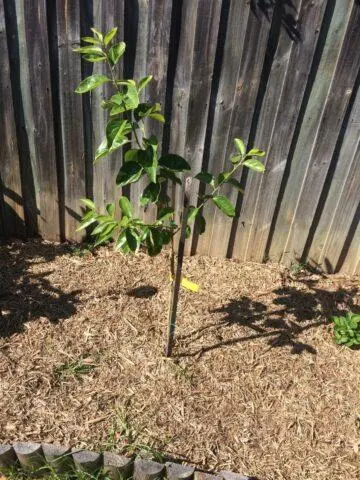Contents
Persimmon planting in autumn is carried out in early November in the southern regions or in mid-October in the middle lane and the Volga region. A seedling at least two years old is bought in special stores or nurseries. Before planting, the roots are soaked in a growth stimulator solution.
Dates of planting persimmons in the fall
Planting persimmon seedlings is planned in the fall 1–1,5 months before the onset of the first frost. In open ground, the tree is grown mainly in the southern regions of Our Country. Here, the first frosts on the soil occur in mid-December. Therefore, the main planting time in the fall is the first decade of November. For the middle lane and the Volga region, this is mid-October.
If the autumn deadline is missed, planting can also be planned for the spring – for the first half of April. In this case, the seedlings will take root more slowly, but on the other hand, they will definitely not suffer from frost. Thus, there are advantages to planting persimmons both in autumn and in spring.
How to plant a persimmon in autumn
Planting persimmons in the fall saves time. Before winter, the seedling will have time to take root, and in the spring it will start to grow. To ensure normal adaptation, it is necessary to choose the right place and prepare it a month before planting.
Site selection
In nature, persimmon grows in tropical and subtropical climates. Therefore, the place for planting a seedling in the fall should be:
- Well lit – even a slight shadow is undesirable.
- Spacious – trees are placed at a distance of 4 m from each other, and one persimmon requires a large area of 8–10 m2.
- On a hill – in the lowlands, water constantly accumulates.
- Without strong drafts – the site should be covered with trees or buildings (while the shadow from them cannot fall on the seedling).
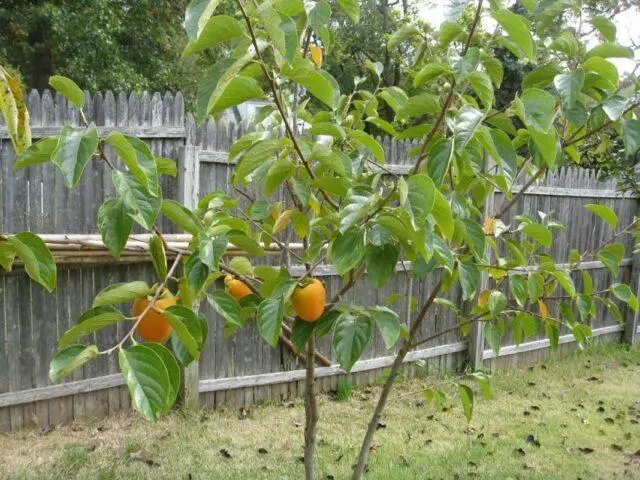
Place for planting persimmon should be protected from the wind
Site preparation
In autumn, it is important to prepare the soil 1–2 months in advance. The best option is fertile, loose loam or sandy loam soil with a slightly acidic reaction (pH about 6,0–6,5). The selected area in August is cleaned and dug up on a spade bayonet. Then add humus or compost in a bucket of 2 m2. If the soil is fertile enough, it is not necessary to fertilize, since in nature persimmon grows well even on rocky soils.
Sometimes heavy clay soil is found on the site. Then, before planting persimmons, you need to dig it up (at the beginning of autumn) and add sand or sawdust in the amount of 1 kg for every 2 m2. If the reaction of the environment is alkaline (pH 7,5 or more), you will also need to water the soil with a solution of 9% food vinegar (100 ml per 10 liters of water per square meter of land).
Choosing a persimmon seedling
Persimmon seedlings for planting in the fall are purchased in special stores, nurseries or from trusted suppliers. This should be done no earlier than the end of October, since it is by this time that the plants are covered with bark.
Basic requirements for planting material:
- In appearance, the seedling should be healthy, without dry, damaged shoots.
- Also, do not buy plants with green bark – they take root worse. Such specimens may not survive winter frosts even in the southern regions.
- Another important criterion is the ability to pollinate. Most persimmon varieties are dioecious, that is, male and female flowers are located on different plants. Therefore, for planting it is better to take 3 seedlings at once – 2 female and 1 male. Although if the variety is self-fertile, this feature is not necessary to take into account.
- The optimal age of persimmon seedlings for planting in the fall is 2 years.

- The root system is closed. During landing, it can be moved along with an earthen clod. To do this, the soil must first be watered.
Rules for planting persimmons in the fall
Instructions for the autumn planting of persimmons:
- In a few weeks, you need to prepare the landing pits. They should be spacious – at least 50 cm deep and wide. The roots should be placed freely, not in contact with the walls.
- A layer of small stones (pebbles, expanded clay, broken bricks) 5 cm high is laid at the bottom. It can be immediately mixed with the ground.
- Fertile soil is covered from above: a sod layer with humus, peat and sand (2: 1: 1: 1) and compacted a little.
- A day before planting in the fall, they take a persimmon seedling, straighten the roots, and, if necessary, remove damaged or rotten parts.
- They put it in a mash from the ground with water and a solution of a growth stimulator – “Epin”, “Kornevin”, “Zircon” or freshly squeezed aloe juice.
- Root into the ground so that the root neck is slightly below the surface.
- They straighten the roots, fall asleep “loosely”, without tamping the soil.
- Place a wooden stake. Tie a persimmon seedling to it.
- Then it is plentifully watered with warm, pre-settled water.
But even in such mild climates, after planting in the fall, it is important to lay down a layer of mulch. It can be cut grass, straw, hay, sawdust, wood chips and other “breathable” materials. The layer height is at least 5 cm.
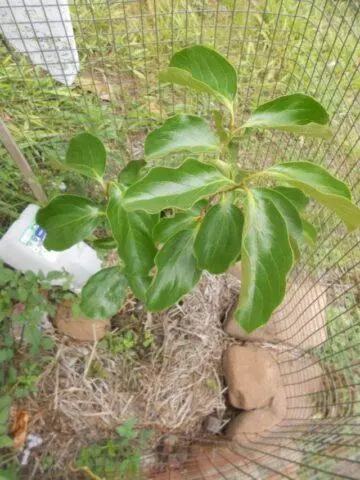
When planted in autumn, persimmon seedlings must be protected from rodents with a chain-link mesh
Persimmon care in autumn
Caring for a tree in the fall after planting is quite simple. It is necessary to water the seedling 1-2 times, as well as mulch the soil and cover it for the winter.
Watering
Even in October-November, a short-term drought can be observed in the southern regions. Therefore, plants are planted in well-moistened soil, and then they act according to the circumstances:
- if the weather is rainy, additional moisture is not needed;
- if there is no rain, watering is done only at the moment when the surface layer dries. For this, distilled water is used.
In the warm season, watering is carried out regularly. In drought up to two times a week, in normal weather – 2-3 times a month. In no case should the soil dry out, although it should not be swamped either.
Additional fertilizing
If the land is fertile enough or the day before compost, humus, other organics are added to it, then it is not necessary to fertilize the plants in the autumn. You can sprinkle the near-stem circle with wood ash (100 g per plant) and then immediately water it. The roots, having received nutrients, will be able to take root faster in a new place. Nitrogen fertilizers are categorically excluded – they are used only in spring and early June.
Trimming
In the first 4–5 years after planting, persimmons must be cut off, and this should be done every autumn (end of October) or every spring (third decade of March). Pruning is carried out for different purposes:
- Sanitary – removal of damaged, weak branches.
- Forming – to create the correct crown.
- Anti-aging – for adult trees older than 5-7 years.
After planting, special attention should be paid to shaping pruning:
- A year later, you need to shorten the main shoot to a height of 80 cm. This stimulates the growth of the root system.
- A year later (in autumn), 4 main branches are outlined. They will bear the brunt. They leave two kidneys. The rest of the pieces are removed.
- Thin branches are also shortened, leaving 5 buds on each of them.
Shelter for the winter
Full shelter is required only for young plants belonging to non-frost-resistant varieties. Moreover, in the south of the planting, it is enough to mulch with peat, sawdust, straw or other materials.
In other regions (Volga region, middle lane), mulch is also laid, its height should be at least 7–8 cm. Seedlings are insulated with spruce branches or burlap, fixing it with a rope. In early April, the shelter is removed, otherwise the plant may overheat.
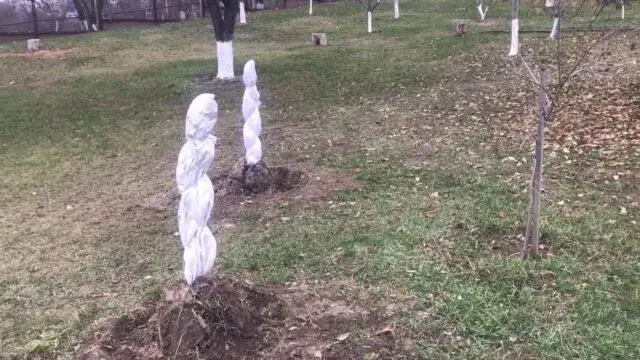
Young seedlings after planting in autumn can be covered with agrofibre
Harvesting and storage of crops
Harvesting is planned for the period from mid-October to early November. The specific period depends on the characteristics of the variety, as well as on the distance over which the crop will be transported. If it needs to be transported too far, the fruits are harvested earlier – still greenish.
When harvesting, it is necessary to work exclusively with secateurs. The fact is that the stalks are very strong, and if you tear the fruit with your hands, you can damage the pulp and even break the branch. Such fruits quickly rot. Since the tree has a large height (3-4 m and above), it is necessary to use a ladder, observing safety measures.
All fruits must be sent for ripening. They can be put in wooden boxes or on newspapers (in several layers). Moreover, you can keep both at room temperature and in a cool room or in the refrigerator (on the bottom shelf). The only requirement is moderate humidity and regular ventilation. The result is the same – the fruits ripen in 10 days.
If some fruits are not ripe, they can be put in a bag with tomatoes or apples for several days or immersed in warm water. The fastest way is to put fruit in the freezer overnight. Then they can be eaten the next day. Optimal storage conditions:
- darkness;
- temperature 0-2 degrees Celsius;
- high humidity (90%).
In such conditions, the fruits are stored for up to three months. If some of them began to rot, then it is better to use them for making jam, jam and other dishes.
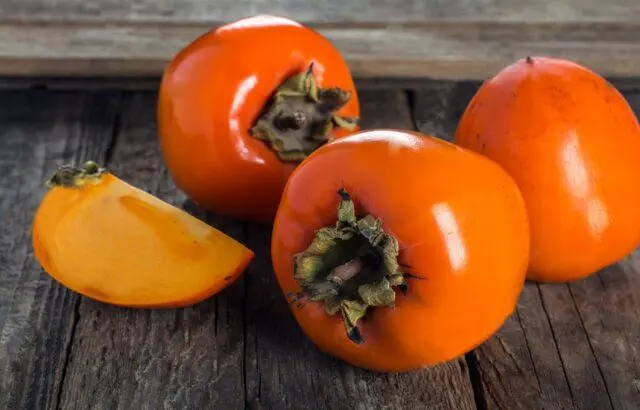
Persimmons are stored for several months at a temperature of no more than two degrees Celsius.
To do this, they are placed in a dark room or covered with a cloth on top, like tomatoes.
Conclusion
Planting persimmons in the fall should be carried out 1,5 months before the first frost. At this moment, the soil should be warmed up to +14–15 °C, and the optimum daily temperature is +18–20 °C. The site is prepared in 1-2 months. It is dug up and fertilized, if necessary, sand or sawdust is added to reduce the density.










